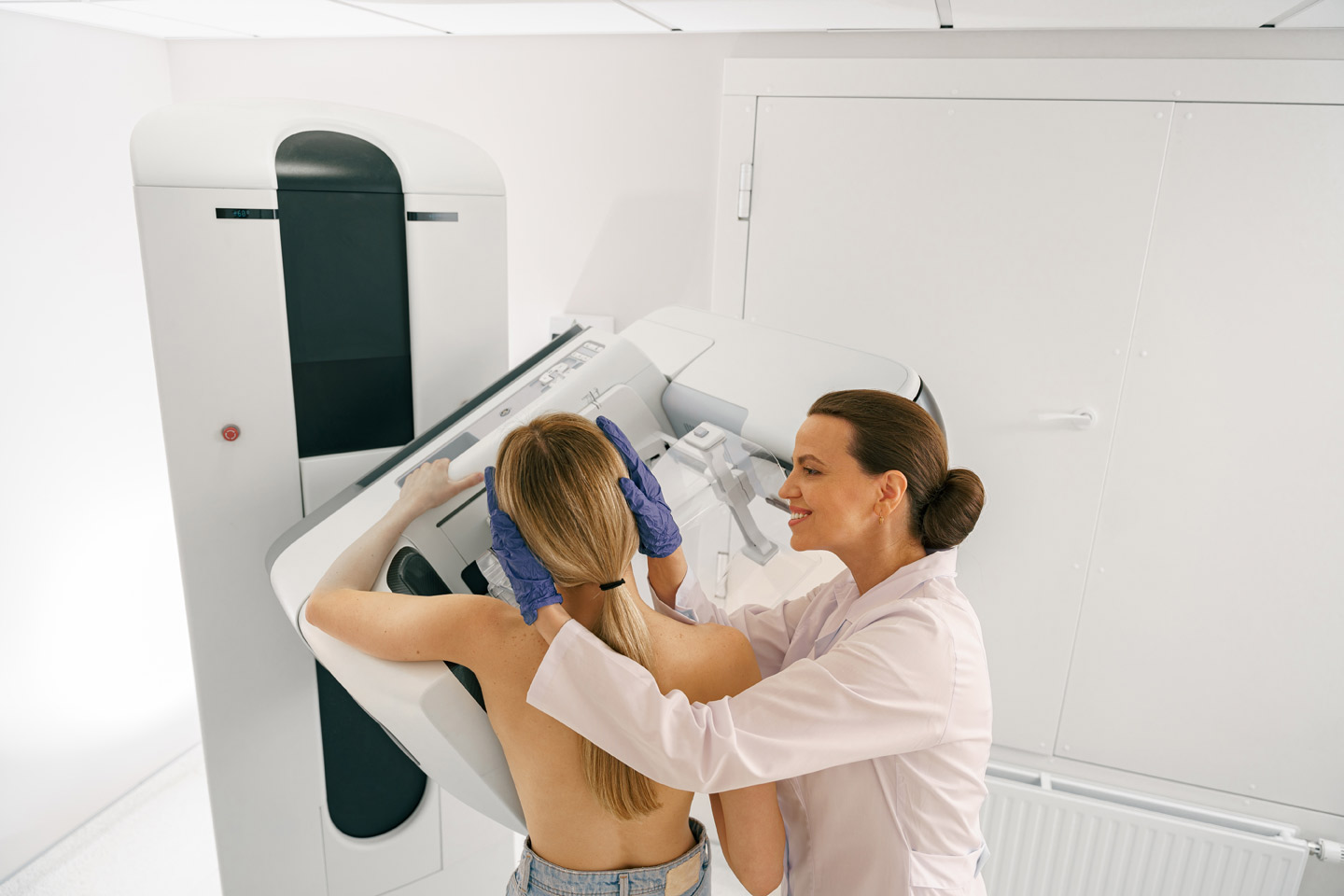Advanced Mammogram Imaging Now Available at Jupiter Medical
Jupiter Medical Center has announced that it is one of the first facilities in the state of Florida to offer state-of-the-art imaging technology as part of its mammography exams.
The Margaret W. Niedland Breast Center has recently installed new equipment that greatly enhances its ability to detect and treat breast cancer. Known as the “New Clarity HD High-Resolution 3-D” platform, it is now being used as part of their “Hologic Genius 3-D™” Mammography exam. It provides the industry’s fastest image processing and delivers the highest resolution images commercially available.
Thanks to this new innovative technology, the Center is able to accelerate screening and analysis. The high-resolution 3-D images clearly reveal subtle lesions and fine calcifications to help detect and pinpoint early stage breast cancer.
The platform also employs sophisticated algorithms that work to produce exceptional 3D images regardless of the patient’s breast size or density. The process is FDA approved, has been shown to detect more serious cancers, and reduce false positives when compared to conventional 2D mammography.
What About COVID?
The center has expanded its safety measure to help protect patients during in-person visits: Here are some of them:
- All patients and staff are screened upon entry to the building, including temperature checks.
- Masks are required for all patients and staff.
- Personal protective equipment is worn at all times by staff.
- Disinfecting and cleaning goes on repeatedly and thoroughly throughout the day including exam rooms,
- No visitors are allowed at this time
- Use of PatientTrak, which allows patients to check in and wait in their vehicle until the time of their appointment.
You should not postpone your routine breast exam over concerns of exposure. Please contact our office if you are interested in being seen at Jupiter Medical Center in order to take advantage of this new technology.
Source: Jupiter Medical Center website, https://www.jupitermed.com/services/breast-health/

Low Vitamin D Level Shown to be a COVID-19 Risk Factor
A large, population-based study at Bar-Ilan University in Israel has discovered a link between Vitamin D deficiency and COVID-19 infection. Patients testing positive for COVID-19 were 50% more likely to have low levels of Vitamin D.
Vitamin D is naturally present in very few foods and is often added as a dietary supplement. It is also produced by the body when ultraviolet rays from sunlight strike the skin. The three main ways of obtaining Vitamin D are 1) Sun exposure, 2) Food, and 3) Supplements.
Some of the foods that are high in Vitamin D are coho and sockeye salmon, Pacific and jack mackerel, rainbow trout, and portobello mushrooms.
The results of the Israeli observational study are supported by previous findings. For example, Dr. JoAnn Manson of Harvard Medical School in Boston cites an earlier observational study conducted at three South Asian hospitals. It likewise found that more severe COVID-19 patients had lower Vitamin D levels.
The Israeli study looked at 7,807 people, ten percent of whom were COVID-19 positive, between February 1 and April 30, 2020. Participants who tested positive tended to be younger and were more likely to be men and live in a lower socioeconomic area.
The key finding of the study determined that only 10% of the COVID-19 positive patients had acceptable Vitamin D levels. This compared to 15% of the COVID-19 negative patients. This difference is statistically significant and makes Vitamin D level a meaningful indicator of the likelihood of infection.
In addition to Vitamin D, the study also looked at other possible indicators. For example, they looked at the presence of dementia, heart disease, lung disorders, and high blood pressure. None of the factors they examined, aside from Vitamin D levels, showed a correlation to COVID-19 infection.
In contrast to previous reports, obesity was likewise not a significant factor associated with increased likelihood for COVID-19 infection in the current study.
According to senior author Milana Frenkel-Morgenstern, PhD, head of the Cancer Genomics and BioComputing of Complex Diseases Lab, she and her colleagues will “try to decipher the potential role of Vitamin D in the prevention and treatment of COVID-19 through additional studies.”
Source: written by Damian McNamara, July 29, 2020, Medscape Family Medicine website, https://www.medscape.com/viewarticle/934835
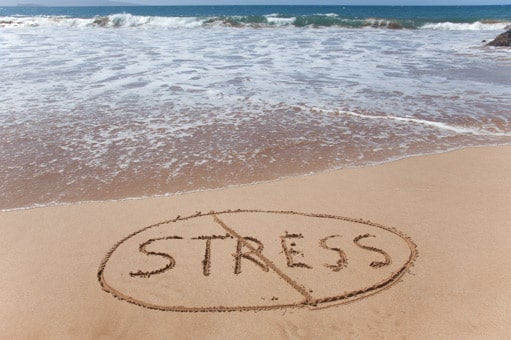
Manage Diabetes by Relieving Stress
A new study from Johns Hopkins University School of Medicine has shown that, in patients with type 2 diabetes, increasing glucose levels are linked to higher levels of the stress hormone, Cortisol.
Cortisol, produced by your adrenal glands, is nature’s built-in alarm system. It works on certain parts of your brain to control your mood, motivation, and fear. It is best known for triggering your body’s “fight-or-flight” instinct in a crisis, but it also plays an important role in a number of other areas such as metabolism, managing inflammation, and regulating your blood pressure.
The results of the Hopkins study show that to maintain better glucose control, patients with type 2 diabetes need to learn to manage stress, as well as pay attention to other lifestyle factors.
“These results suggest a detrimental role of cortisol contributing to glycemia (glucose in the blood) among individuals with diabetes,” said physiologist Jenny Pena Dias, who headed the study.
“Stress relief is a crucial and often forgotten component of diabetes management,” she stated.
“Whether it’s reading, taking a yoga class, or taking a walk, finding ways to lower your stress levels is important to everyone’s overall health, especially for those with type 2 diabetes.”
Normally, Cortisol levels are at their highest at about 30 minutes after getting up in the morning. Then they steadily decline during the day. The study looked at Cortisol levels in 1,275 participants over a period of six years. The study also looked at each participant’s glucose level. Eighteen percent of the participants had type 2 diabetes.
The results among the diabetes participants showed that for every increase in the level of Cortisol, there was an associated increase inplasma glucose.
These results were confined only to the participants who were diagnosed with type 2 diabetes. They did not occur among any of the other participants. This indicates that a link between heightened glucose levels and increased Cortisol levels exists among patients with diabetes. It can therefore be inferred that by reducing Cortisol levels via changing behavior in order to reduce stress, diabetes sufferers can better manage their condition.
“Future studies are needed to examine these relationships…to determine the mechanisms by which changes in Cortisol secretion disrupt glucose metabolism, and to develop future targets for treatment of type 2 diabetes,” Pena Dias noted.
The Johns Hopkins group has also started a trial to examine if mindfulness practices can lower blood glucose in people with type 2 diabetes.
However, practicing mindfulness isn’t the only effective form of stress relief, they pointed out. “It’s important to find something you enjoy and make it a part of your everyday routine.”
Source: Psychoneuroendocrinology. Published online July 13, 2020. https://www.medscape.com/viewarticle/933877
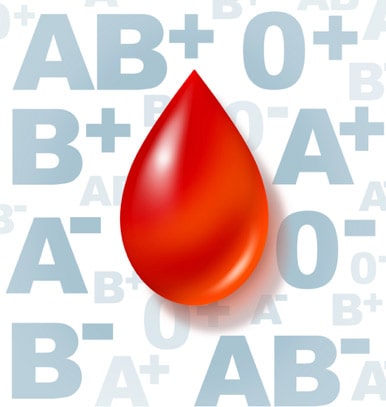
Is There A Connection Between Blood Type and COVID-19?
A recent study conducted at five Boston hospitals looked at the blood types of 1289 COVID-19 patients. The researchers looked for a connection between a patient’s blood type and the severity of his or her symptoms. They found no such connection.
“Blood type does not relate to the severity of COVID,” said Dr. Anahita Dua, a vascular surgeon who headed the study. “Other links between blood type and COVID deserve further study, however.”
Another recent study, published in the New England Journal of Medicine reported a link between a patient’s genetic markers and COVID. They identified a certain gene cluster among patients who suffered respiratory failure and determined there was a “potential involvement” of the ABO blood type.
This involvement indicates the need for further research, said Dr. Dua.
“It’s not unheard of that a genetic difference in people would result in a different outcome with COVID.”
The Boston study also turned up another interesting finding. Symptomatic patients with Type O blood seemed to test positive at a lower rate than those with Type B or Type AB. The likelihood of a positive test was also lower among those with a positive Rh factor.
The following table lists the “odds” of testing positive given a patient’s blood type. A value that is less than one means that a patient with that blood type is less likely than average to test positive. A value greater than one means the patient is more likely:
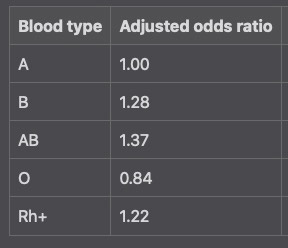
Blood type AB+ was shown to be the most likely to produce a positive outcome, while O- was the least likely.
The researchers also looked at the correlation between blood type and inflammation. They found no such connection.
There is a precedent for a link between disease and blood type — malaria is an example — and the researchers said they would not rule out that blood type could play some role in understanding COVID-19. They encouraged further study.
The researchers stressed that no one should draw the wrong conclusions from this study. “We would never tell someone with type O blood to be less cautious about wearing a mask, washing hands, or social distancing,” Dr. Dua said. “We all need to be extra cautious.”
Source: Marcia Frellick, Medscape Family Medicine, July 21, 2020, https://www.medscape.com/viewarticle/934313
Hopes Are High For A Coronavirus Vaccine
On July 20, positive test results from three different COVID-19 studies have managed to raise hopes that an effective vaccine may soon be on its way. One of the three involved a closely-watched project being developed at Oxford University. All three vaccines under development are designed to train a person’s immune system to recognize and fight the novel coronavirus without causing any serious side effects.
Whether any of these initiatives will result in a vaccine capable of protecting billions of people and ending the global pandemic that has claimed more than 670,000 lives is still far from certain. All will require much larger studies to prove they can safely prevent infection or serious disease.
The vaccine being developed by British drugmaker AstraZeneca at Oxford University, brought about an immune response in all study participants. There were no worrisome side effects.
Another vaccine under development by CanSinoBiologics, part of China’s military research division, likewise showed that it was safe and created an immune response in most of the 508 healthy volunteers. There were also no serious side effects reported.
Both the AstraZeneca and the CanSino vaccines use another virus, called an adenovirus, to carry genetic material from the coronavirus into the body. This material triggers the creation of antibodies.
The third vaccine works in a different way. It uses RNA (ribonucleic acid). RNA is a chemical messenger that causes cells to create proteins. Two companies, BioNTech in Germany and Pfizer in the U.S. are using this technique to create a vaccine that instructs cells to create proteins that mimic the outer surface of the coronavirus. The body recognizes these as foreign invaders and then creates an immune response which combats the actual coronavirus.
This is the same method being developed by American drugmaker, Moderna. The recent study involved 60 healthy patients. The test vaccine created virus-neutralizing antibodies in all patients given two doses.
None of these leading contenders have resulted in side effects that could sideline their efforts—so far,. All must still prove they are safe and effective in trials involving thousands of subjects, including those at high-risk for severe COVID-19, such as the elderly and people with diabetes.
Several manufacturers have U.S. government backing with a goal of having a coronavirus vaccine by year’s end as cases continue to rise at a record pace.
The most encouraging news is that experimental vaccines all appear to be effective. The level of antibody creation brought on by these vaccines is identical to those produced by people who actually survived COVID-19 and are considered to be relatively immune.
Source: Julie Steenhuysen, Reuters World News. July 20, 2020, https://www.reuters.com/article

Pre-diabetes Is Connected to Increased Risk of Death From Cardiovascular Disease
A recent gigantic analysis looked at 129 different studies, over a span of ten years, and involving more than ten million patients.
It was conducted in Foshan, China and examined the link between pre-diabetes and mortality. It showed that such a link definitely exists.
The increased risk of death was accompanied by an increased risk, among patients with pre-diabetes, of cardiovascular disease, coronary heart disease and stroke. Similar results were shown in a corresponding study that spanned only a three-year period, with the exception that there was no increased risk of stroke.
This finding indicates that stroke, unlike cardiovascular and coronary disease, may be more of a long-term consequence of pre-diabetes.
“Successful intervention in this large population could have a major effect on public health,” said Xiaoyan Cai with Foshan’s Southern Medical University where the analysis was conducted.
COVID-19 LOCAL SITUATION SUMMARY
Here is the latest update from area hospitals, assisted living facilities and nursing homes as of July 24, 2020:
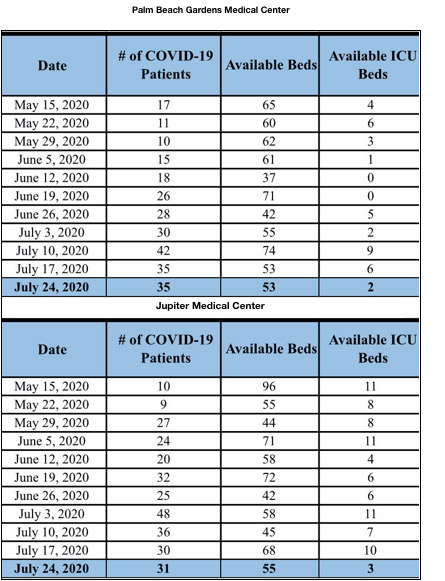
LINKS TO LEARN MORE ABOUT CORONAVIRUS:
CDC Corona Virus Prevention Page
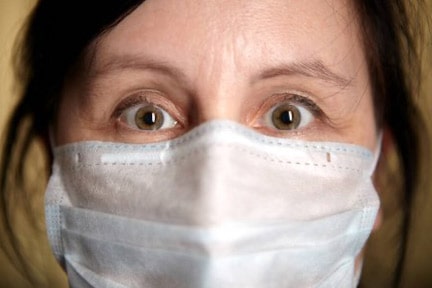
How to avoid COVID-19 Stress
Many people are reporting increased levels of stress due to the fears surrounding the coronavirus pandemic. In addition to calling your doctor when necessary, here are some tips that will help you deal with increased stress these days.
Joseph McGuire, Ph.D., M.A., a child psychologist with Johns Hopkins University School of Medicine, offers the following advice for you and your family on how to manage coronavirus-related stress.
1. Don’t panic
Don’t get overwhelmed by all the non-stop media coverage of the pandemic—much of it contradictory and swiftly changing.
McGuire recommends using credible sources such as the Centers for Disease Control and Prevention or the World Health Organization to obtain up-to-date, scientific information about the illness and how to prevent it.
“Knowledge and preparation can help reduce feelings of panic,” says McGuire. “Individuals can use information from trusted resources to develop personal plans of action.”
One such trusted resource is Weisz Concierge Medical. If you are unsure about COVID-19, phone or email our office and Dr. Weisz will be back to you promptly with reliable information.
2. Keep the kids informed
It’s not surprising that children may feel afraid or anxious about the coronavirus. It’s important to validate feelings of worry and not dismiss them, advises McGuire. He offers the following tips:
Listen. After hearing their children out, parents should …
Provide accurate information. Determine what your children already know about the virus and then provide information they can understand and trust.
Focus on prevention. Keep discussions focused on preventive actions. Set up and praise healthy hand-washing habits, and maintain regular routines for playtime, meals and other activities.
If someone in your family is sick with COVID-19, it can be hard for children to understand what’s going on and how they should act.
“This is where it is important to have an established plan to minimize the worries and keep the kids focused on proactive solutions,” says McGuire. “You know your children and how they learn best — make sure that your explanations are clear and helpful.”
3. Mindfulness
Taking steps to reduce your stress in a healthy way is important. Stress can affect the immune system, but it is uncertain whether short-term stress makes someone more likely to catch the new coronavirus, says McGuire.
One way to lessen worry is to ground yourself in the present moment through mindfulness. “Mindfulness is a great technique that can help reduce stress during challenging times,” says McGuire. Anyone can practice mindfulness. It requires no special training. You can practice mindfulness by sitting quietly and focusing on your breathing and senses.
Another way to manage stress is by limiting computer screen time and media exposure. “While keeping informed about current events is important, too much attention can cause problems,” explains McGuire. “Setting boundaries can prevent feeling overwhelmed by the situation.”
“It is important to not let fear control your life,” concluded McGuire.
Source: Joseph F McGuire, M.A., Ph.D., Johns Hopkins Medicine website, https://www.hopkinsmedicine.org/health
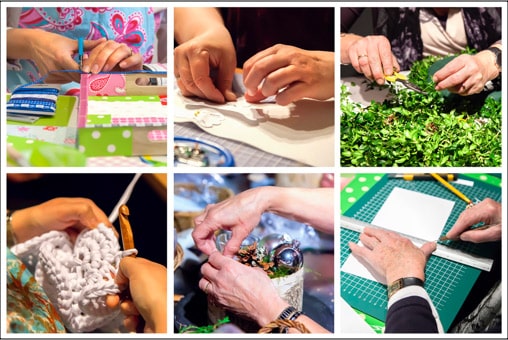
Top Ten Great Stay-At-Home Hobbies
What can you do when you and your family finally hit your binge-watching wall? It’s the perfect time to try a new hobby and learn something while staying entertained.
If you have a craft bin, a yoga mat, and some flour, you likely already have all of the supplies you need on hand. And while the idea is to cut down on screen-watching time, we’ll give it a pass if it’s to follow along with knitting or embroidery tutorial videos. Grab some yarn and get ready to find your new favorite hobby.
1. Knit or crochet
If you have some yarn on hand, let YouTube videos (or a family member who already knows how) teach you to knit or crochet. In need of supplies? Check out the beginner kits at We Are Knitters and Wool and the Gang, which can be delivered right to your door.
2. Watercolor painting
If you have an old set of watercolors hiding in a craft bin or storage box somewhere in your house, it’s time to break it out. The process of painting can be very soothing, even if the finished result isn’t a masterpiece.
3. Calligraphy
Whether you already own a calligraphy pen, or just some felt-tip pens or gel pens, you can still try your hand at calligraphy or hand-lettering. YouTube has tons of hand-lettering tutorials to choose from, no matter if you’re using a brush marker or some colored pencils borrowed from your kids.
4. Yoga
Unroll that yoga mat that’s been collecting dust in the corner of your room. Because yoga combines mindful movement with breath work and meditation, it’s the ultimate de-stressing hobby. If you’re a beginner, start out slow and don’t overdo it. Check out the popular YouTube channel Yoga with Adriene, and try yoga for complete beginners or yoga for anxiety.
5. Dancing
Trying to convince your family (and yourself) to get up off the couch? Put on some music for motivation. Join all of TikTok in attempting the Renegade dance, or brush up on the cha-cha, tango, or waltz. You’ll be ready to hit the dance floor once all of those postponed weddings are rescheduled.
6. Plant a garden
Whether you have an entire backyard to dedicate to a vegetable garden, or a small windowsill to cultivate an herb garden, digging in dirt and growing something can be very therapeutic.
7. Learn some magic tricks
As long as you have a pack of cards or a quarter (bonus points for a scarf or a flock of doves), you can learn some simple magic tricks. Follow along with video tutorials on YouTube, or there’s even a MasterClass you can take on the art of magic taught by Penn & Teller.
8. Build your own sourdough starter
On my last venture out to the grocery store, I was disappointed to see that dry active yeast was completely out of stock. I thought my challah-making plans were foiled, until I realized you can make your own sourdough starter using just flour and water. The process takes about a week, but hey, we have the time, right? Follow the directions online at King Arthur Flour.
Sourdough starter is a fun science experiment as much as it is a baking challenge, so if you have kids at home, it’s a great project to get them involved with.
9. Make a family scrapbook
If you’re spending quarantine going through old family photos anyway, why not turn them into a family scrapbook, complete with detailed captions and decorative borders? You’ll be glad you did when you get to look back on your creation years from now.
10. Embroidery
Grab an old T-shirt or tablecloth and give it a hand-embroidered upgrade. If you have embroidery floss and a needle, you have everything you’ll need for this project. Start by learning the basics—running stitch, satin stitch, and French knot—then repeat those stitches again and again to create your own work of art.
Source: By Katie Holdefehr Updated June 27, 2020. Real Simple website., https://www.realsimple.com/work-life/entertainment/crafts-hobbies/new-hobbies-to-try
ON THE LIGHTER SIDE


TWO GREAT HEALTHY STAY-AT-HOME RECIPES
We’ve gotten some terrific “feed”- back about the recipes we’ve been publishing. Here are two more that are healthy and easy to prepare. Bon Appétit!
Turkey escalopes & giant couscous
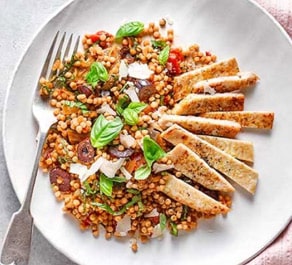
Tick the healthy and budget-friendly boxes with our turkey escalopes and giant couscous. It’s tasty, filling and packed with good-for-you ingredients
Ingredients
- 3 tbsp rapeseed oil
- 1 onion
- 1 aubergine cut into 3cm cubes
- 2 large garlic cloves, crushed
- ¼ tsp chili flakes
- 14 oz. can chopped tomatoes
- 2.5 oz. black olives, pitted and sliced
- 1 lemon, zested
- 4 turkey escalopes
- 9 oz. giant couscous
- ½ small bunch basil, chopped, plus some extra torn leaves to serve
- 1 oz. parmesan, shaved, to serve
Directions
Heat 2 tbsp of the oil in a saucepan over a medium heat. Fry the onion and aubergine for 15-20 mins, or until softened. Add the garlic and chili flakes and cook for 1 min more. Tip in the tomatoes and olives and cook for another 10 mins.
Meanwhile, heat the grill high. Mix the remaining oil and the lemon zest together, then rub on both sides of the turkey escalopes. Put the escalopes on a baking sheet and grill for 5-6 mins on each side serving until cooked through.
Cook the couscous following pack instructions, then drain and stir through the tomato sauce along with the basil. Slice the escalopes and serve with the couscous, parmesan and extra basil leaves.
Nutrition Facts

Source: Good Food magazine, July, 2020
Spiced salmon & tomato casserole
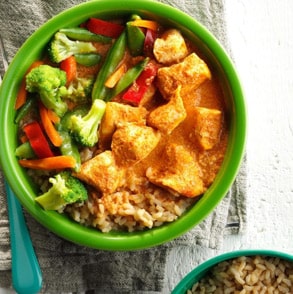
Enjoy this healthy spiced salmon and tomato casserole with a mild curry flavor for a quick and easy midweek meal. Serve with naan bread and lemon wedges
Ingredients
- 1 red onion, sliced
- 7 oz. cherry tomatoes
- 3 tbsp mild or madras curry paste
- 14 oz. can chickpeas, drained and rinsed
- 2 skinless salmon fillets
- 1 large or 2 small naan breads2 tbsp fat-free yogurt
- lemon wedges and a few coriander leaves, to serve (optional)
Directions
Heat the oven to 400 degrees F. Toss the onion, tomatoes, 2 tbsp curry paste, the chickpeas and 1 cup water together in a deep 8 in. x 9 in. roasting tin. Roast for 15 mins until the onions are tender and the tomatoes are just bursting.
Stir everything, then season. Brush the remaining curry paste over the salmon fillets and season. Nestle the salmon into the veg in the tin and roast for another 8-10 mins, or until cooked to your liking.
Meanwhile, warm the naan breads – you can do this by putting them directly on the oven rack below the roasting tin. Cut the warmed naan breads into wedges. Swirl the yogurt into the veg in the tin, then serve with the naan wedges for dunking, a few coriander leaves sprinkled over, if you like, and the lemon wedges, if using, for squeezing over..
Nutrition Facts

Source: Good Food magazine, September 2019
